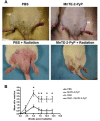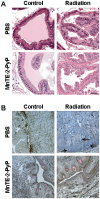The antioxidant, MnTE-2-PyP, prevents side-effects incurred by prostate cancer irradiation
- PMID: 22984473
- PMCID: PMC3440381
- DOI: 10.1371/journal.pone.0044178
The antioxidant, MnTE-2-PyP, prevents side-effects incurred by prostate cancer irradiation
Abstract
Prostate cancer is the most commonly diagnosed cancer, with an estimated 240,000 new cases reported annually in the United States. Due to early detection and advances in therapies, more than 90% of patients will survive 10 years post diagnosis and treatment. Radiation is a treatment option often used to treat localized disease; however, while radiation is very effective at killing tumor cells, normal tissues are damaged as well. Potential side-effects due to prostate cancer-related radiation therapy include bowel inflammation, erectile dysfunction, urethral stricture, rectal bleeding and incontinence. Currently, radiation therapy for prostate cancer does not include the administration of therapeutic agents to reduce these side effects and protect normal tissues from radiation-induced damage. In the current study, we show that the small molecular weight antioxidant, MnTE-2-PyP, protects normal tissues from radiation-induced damage in the lower abdomen in rats. Specifically, MnTE-2-PyP protected skin, prostate, and testes from radiation-induced damage. MnTE-2-PyP also protected from erectile dysfunction, a persistent problem regardless of the type of radiation techniques used because the penile neurovascular bundles lay in the peripheral zones of the prostate, where most prostate cancers reside. Based on previous studies showing that MnTE-2-PyP, in combination with radiation, further reduces subcutaneous tumor growth, we believe that MnTE-2-PyP represents an excellent radioprotectant in combination radiotherapy for cancer in general and specifically for prostate cancer.
Conflict of interest statement
Figures









References
-
- Siegel R, Naishadham D, Jemal A (2012) Cancer statistics, 2012. CA Cancer J Clin 62: 10–29. - PubMed
-
- Sullivan L, Williams SG, Tai KH, Foroudi F, Cleeve L, et al. (2009) Urethral stricture following high dose rate brachytherapy for prostate cancer. Radiother Oncol 91: 232–236. - PubMed
-
- Merlin SL, Brock GB, Begin LR, Hiou Tim FF, Macramalla AN, et al. (2001) New insights into the role of endothelin-1 in radiation-associated impotence. Int J Impot Res 13: 104–109. - PubMed
Publication types
MeSH terms
Substances
LinkOut - more resources
Full Text Sources
Other Literature Sources
Medical
Miscellaneous

